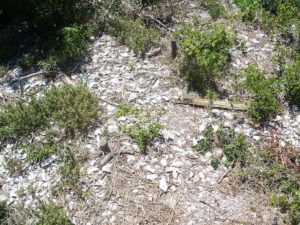
NATIONAL PARK SERVICE, TALLAHASSEE, FL – National Park Service (NPS) archeologists provided valuable research for a new global study finding
Archeologists from NPS’s Southeast Archeological Center (SEAC) joined an international research team for this study published in Nature Communications magazine last month. The researchers analyzed Indigenous oyster harvest sites in North America, including at three national parks and Australia, dating from as far back as 6,000 years. They learned oyster harvest sites were significantly more productive for thousands of years when managed by Indigenous communities. Today, a major decline in oyster fisheries is a global concern.
“This study is significant because it highlights the importance of Indigenous knowledge in ecosystem management. A failure to take traditional ecological knowledge into account contributed to the collapse of oyster fisheries associated with European settlement,” stated NPS archeo
Archeological data from shell mounds in Canaveral National Seashore, De Soto National Memorial and Everglades National Park contributed to this study. Using scientific techniques, such as radiocarbon dating, NPS archeologist Dr. Margo Schwadron and her team of researchers, including Lockman, concluded that Indigenous people lived sustainably for many thousands of years before the arrival of European colonists and integrated knowledge and sustainability practices that modern-day conservationists can learn from. As such, this study helps the NPS advance its core mission “to conserve the scenery and the natural and historic objects and the wildlife therein and to provide for the enjoyment of the same in such manner and by such means as will leave them unimpaired for the enjoyment of future generations,” the National Park Service Organic Act, 1916.
“I am thrilled to see the excitement being generated by this article, but more importantly I am happy to be working with tribal partners and engaging in important science and research that recognizes the incredible traditional, ecological knowledge of our tribal partners,” said Schwadron.
As an archeologist with SEAC, Schwadron has passionately documented and worked to preserve coastal shell sites in national parks in the southeastern United States for over 30 years, including working with other scientists to restore natural ecosystems and build living shorelines to protect natural and cultural areas. She has led efforts to document and protect NPS coastal shell mounds, advocating for their preservation as significant cultural resources that provide a unique understanding of climate change, historical ecology and traditional culture and ecological knowledge.
One shell mound included in the new Indigenous fisheries study is Turtle Mound located at the Canaveral National Seashore in Florida. It is the largest mound in the NPS system and possibly the tallest in North America, standing 37-feet tall. Turtle Mound contains archeological material that has been in existence for more than 1,200 years, from 800 to 1400 CE. The mound is effectively a time capsule providing evidence of the past in terms of food, tools and other artifacts.
Climate change effects are already producing detrimental impacts to these mound sites, including erosion and loss of significant archeological, environmental and palaeoecological data. Impacts from sea-level rise and increased storm activities are predicted to continue to accelerate erosion, loss of archeological data and eventual total loss of site integrity.
______________________________

Oyster shells visible through vegetation on Turtle Mound. Ebyabe, Creative Commons Attribution-Share Alike 3.0 Unported, Wikimedia Commons
______________________________
Article Source: NPS news release
NPS works with partners, universities and non-profits to preserve and protect these sites so future generations will continue to learn lessons from our past.
About the National Park Service: More than 20,000 National Park Service employees care for America’s 423 national parks and work with communities across the nation to help preserve local history and create close-to-home recreational opportunities. Learn more at www.nps.gov, and on Facebook, Instagram, Twitte
____________________________




